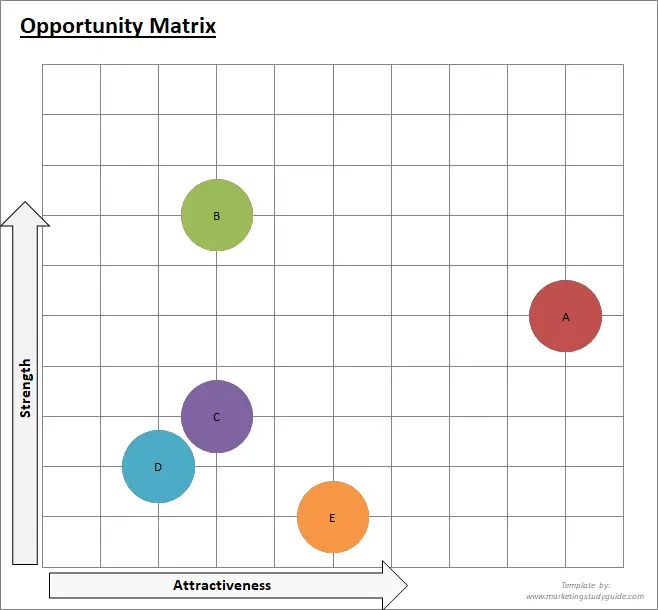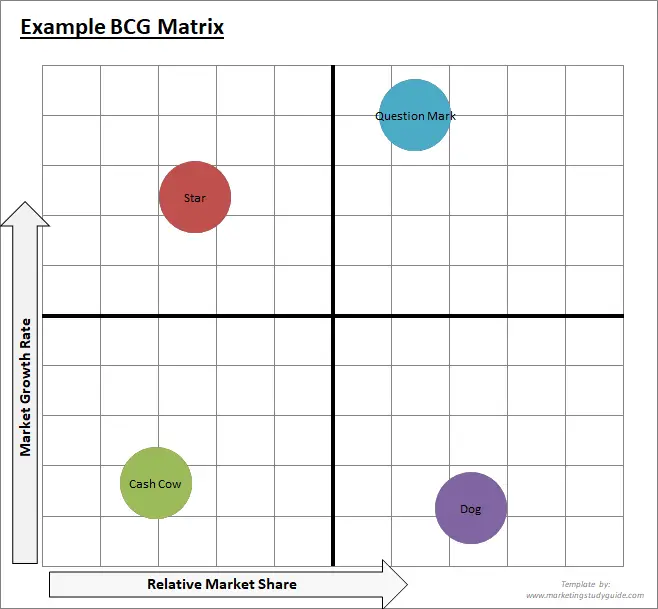Contents
About the Matrix Maker
A matrix demonstrates the relationships between two attributes in a visual graph format, similar to a scatter-plot chart. However, it is often time-consuming for someone new to Excel to construct a matrix, as the chart needs a reasonable amount of formatting.
That’s why have developed a free Excel matrix template for download.
Please click here to download the free Excel matrix template…
What the Free Matrix Template looks like
When you download and then open the Excel matrix template, it will look like this…
As you can see, you are guided through the development of a matrix, with the six simple steps clearly outlined in yellow cells and you enter into the blue cells.
On the right-hand side, as you progressively establish your matrix, you can see a mini version of the matrix, but with the fully formatted matrix chart underneath, which looks like this…
As you can see above, it is a simple, yet powerful, tool for reports and presentations. You have full control of the design of your matrix and you can easily modify it by following the steps in the template, namely :
- You enter the title of the matrix,
- Name the two attributes,
- Name the circles in the chart,
- Enter of the data that determines where they sit in the matrix
- And change the circle sizes
You can Also Construct a BCG Matrix Using the Template
Probably one of the most well-known matrices is the Boston Group Consulting (BCG) matrix, which includes the cash cows, dogs, stars and question marks.
This free matrix template has the ability for you to construct the BCG matrix, here is an example of its output…
Video Instructions for the Free Excel Matrix Maker
Reasons to Use a Matrix in Marketing
Organize and categorize information
Matrix diagrams provide a structured framework for organizing and categorizing information. They help in visually representing complex data sets, relationships, and interdependencies between different elements.
Analyze and evaluate options
Matrix diagrams facilitate analysis and evaluation by allowing businesses to compare and assess different options or criteria. They provide a systematic approach for evaluating alternatives, identifying strengths and weaknesses, and making informed decisions.
Identify priorities and focus areas
Matrix diagrams help in identifying priorities and focus areas by highlighting critical factors or elements. They allow businesses to allocate resources, set goals, and prioritize actions based on the relative importance or impact of different elements.
Improve communication and collaboration
Matrix diagrams enhance communication and collaboration by providing a visual representation that is easy to understand and share. They help in conveying complex information, facilitating discussions, and aligning stakeholders on common goals and strategies.
Support problem-solving and decision-making
Matrix diagrams are valuable tools for problem-solving and decision-making processes. They provide a structured approach to identify and analyze options, consider trade-offs, and evaluate the potential outcomes or impacts of different decisions.
Commonly Used Matrices in Marketing
SWOT Analysis:
A SWOT (Strengths, Weaknesses, Opportunities, Threats) matrix helps in assessing the internal strengths and weaknesses of a business and the external opportunities and threats it faces. It aids in strategic planning, identifying competitive advantages, and mitigating risks.
BCG Matrix:
The BCG (Boston Consulting Group) matrix is used to analyze a company’s portfolio of products or business units. It categorizes them into four quadrants based on their market growth rate and relative market share.
The matrix helps in making investment decisions, resource allocation, and portfolio management.
Ansoff Matrix:
The Ansoff matrix helps in evaluating growth strategies for a business by considering the relationship between existing and new products and existing and new markets.
It provides four growth strategies: market penetration, market development, product development, and diversification.
Decision Matrix:
A decision matrix, also known as a decision-making matrix or grid, is used to compare and prioritize options based on multiple criteria. It assigns weights to different factors and evaluates alternatives against those criteria to make informed decisions.
Further Reading (External Link)
Related Articles and Tools



